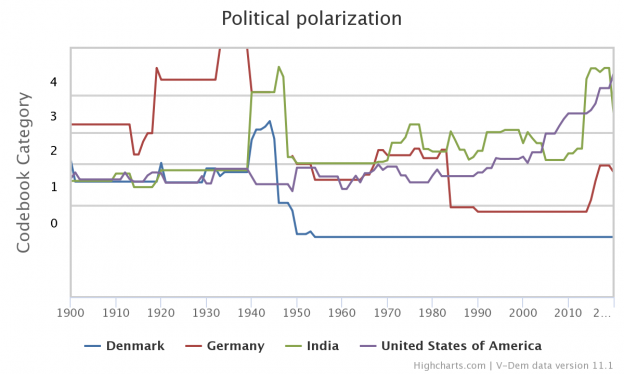- Facebook63
- Threads
- Bluesky
- Total 63
A comparative approach is useful for testing theories about one of the prominent phenomena of our time: polarization.
If you assume that people naturally polarize because of hard-wired features, such as the human tendency to prefer members of our own groups, then you would expect levels of polarization to be consistent across time and countries.
If you assume that polarization is specifically an American issue, you might look at unusual features of US society that have persisted over time, such as our two-party system, the salience of race and racism, sheer size, the private news media, or the fact that we have several regional elites who don’t necessarily know each other (Wall Street financiers, Texas oilmen, Silicon Valley entrepreneurs, etc.).
If you assume that the problem is global and recent, you might look at international developments, such as social media, plutocracy, the decline of a neoliberal consensus, or the revival of illiberal nationalism.
If you assume that the problem is specifically American and recent, you might focus on changes in the US system, such as the departure of Southern conservatives from the Democratic Party after the 1960s, or the replacement of national party structures with entrepreneurial candidates, or more sophisticated gerrymandering, or the election of Barack Obama, which may have alerted some White voters to the emerging reality that the Democrats are decisively more diverse than the Republicans:
The comparative graph for this post illustrates a few selected points.
FIrst, current levels of polarization in the USA are comparable to those in Weimar Germany or India at the time of partition and worse than Denmark’s under occupation. Bolsonaro’s Brazil and Venezuela score even higher than the USA today, but that is not good company. Polarization cannot be hard-wired if it varies so much, and our levels are alarming.
Second, social media cannot simply and straightforwardly explain the recent growth in polarization, for media would affect tech-savvy Denmark as much as the USA. Yet Denmark is one of several democracies that demonstrate consistently low polarization. (The EU as a whole shows some increase in polarization since 2000, but much less than the USA.)
Third, the USA has seen polarization increase a lot lately, which works against explanations that evoke stable features of US society, such as the two-party system.
I am not one who views polarization as an intrinsic evil. If a society is divided between democrats and authoritarians, the problem is not polarization; it is the authoritarians. Less division between good and bad players may indicate a harmful compromise. In the Weimar case, I think polarization posed a challenge to the fragile representative system, but the main problem was the Nazis. (Stalinists made things worse.) Describing Weimar as an example of “polarization” suggests that there were several groups who just didn’t get along. Instead, some groups belonged in jail.
Nevertheless, polarization poses challenges of its own. It encourages political actors at all levels to push their own rights and interests to the limits, without concern for any collateral damage to the institutions. The levels in the USA today exceed those in comparable countries by large margins and resemble those recorded just before notorious historical disasters.
Caveat: the graph (from V-Dem) does not show objective measures of polarization, but the assessments of social scientists who study these countries. See also: affective polarization is symmetrical; promoting democracy and reducing polarization; empathy boosts polarization; marginalizing views in a time of polarization; civic education in a time of inequality and polarization; vaccination, masking, political polarization, and the authority of science
